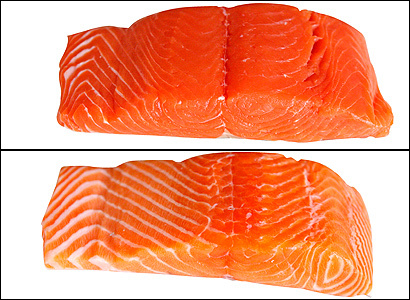ITS VERY IMPORTANT TO US @ THATPLUM TO GIVE OUR FOLLOWERS INFORMATION ON HOW TO HAVE A DAILY HEALTHY LIFESTYLE.
FARMED VS WILD FISH

Many of you are unaware of the dangers in eating farmed fish verses wild fish. Due to economical reasons, one tends to opt and buy the cheaper meal version.Some of these stores are not necessarily interesting in your health over profit, so its up to you the consumer to do your research.
Last year, the USDA increased its seafood recommendation to 8 ounces per week, and that has led many to believe that all fish are equally smart choices. But some are so high in contaminants like mercury that their health benefits are outweighed by their health risks. Others are flown in from halfway around the world, but given labels that make you think they were caught fresh earlier that morning. And still others are raised in filthy
, overcrowded pools and loaded up with chemicals to keep them alive.
#1: ATLANTIC BLUEFIN TUNA
Why It’s Bad: A recent analysis by The New York Times found that Atlantic bluefin tuna has the highest levels of mercury of any type of tuna.
Eat This Instead: Opt for American or Canadian (but not imported!) albacore tuna, which is caught while it’s young and doesn’t contain as high levels of mercury.
#2: ATLANTIC SALMON (Both Wild-caught and Farmed)
Why It’s Bad: It’s actually illegal to capture wild Atlantic salmon because the fish stocks are so low, and they’re low, in part, because of farmed salmon. Salmon farming is very polluting: Thousands of fish are crammed into pens, which leads to the growth of diseases and parasites that require antibiotics and pesticides. Often, the fish escape and compete with native fish for food, leading to declines in native populations.
Eat This Instead: Opt for Wild Alaskan salmon.
3: ATLANTIC FLATFISH
Why It’s Bad: This group of fish includes flounder, sole, and halibut that are caught off the Atlantic coast. They found their way onto the list because of heavy contamination and overfishing that dates back to the 1800s. According to Food and Water Watch, populations of these fish are as low as 1 percent of what’s necessary to be considered sustainable for long-term fishing.
Eat This Instead: Pacific halibut seems to be doing well, but the group also recommends replacing these fish with other mild-flavored white-fleshed fish, such as domestically farmed catfish or tilapia.
4: IMPORTED KING CRAB
Why It’s Bad: The biggest problem with imported crab is that most of it comes from Russia, where limits on fish harvests aren’t strongly enforced. But this crab also suffers from something of an identity crisis: Imported king crab is often misnamed Alaskan king crab, because most people think that’s the name of the crab. And supermarkets often add to the confusion by labeling imported king crab “Alaskan King Crab, Imported.” But Alaskan king crab—crab that actually hails from the great state of Alaska—is a completely separate animal and is much more responsibly harvested than the imported stuff.
Eat This Instead: When you shop for king crab, whatever the label says, ask whether it comes from Alaska or if it’s imported. Approximately 70 percent of the king crab sold in the U.S. is imported, so it’s important to make that distinction and go domestic.
#5 IMPORTED SHRIMP
Why It’s Bad: Imported shrimp actually holds the designation of being the dirtiest of all the seafood we looked at. (For our full list, check out 12 Fish You Should Never Eat.) Problem is, 90 percent of shrimp sold in the U.S. is imported. Imported farmed shrimp comes with a whole bevy of contaminants including antibiotics, residues from chemicals used to clean pens, E. coli, mouse hair, rat hair, and pieces of insects. Yum! Part of this has to do with the fact that less than 2 percent of all imported seafood (shrimp, crab, catfish, or others) gets inspected before its sold, which is why it’s that much more important to buy domestic seafood.
Eat This Instead: Domestic shrimp. Seventy percent of domestic shrimp comes from the Gulf of Mexico, which relies heavily on shrimp for economic reasons. Pink shrimp from Oregon are another good choice; the fisheries there are certified under the stringent Marine Stewardship Council guidelines.
Eat This, Not That
by David Zinczenko with Matt Goulding
